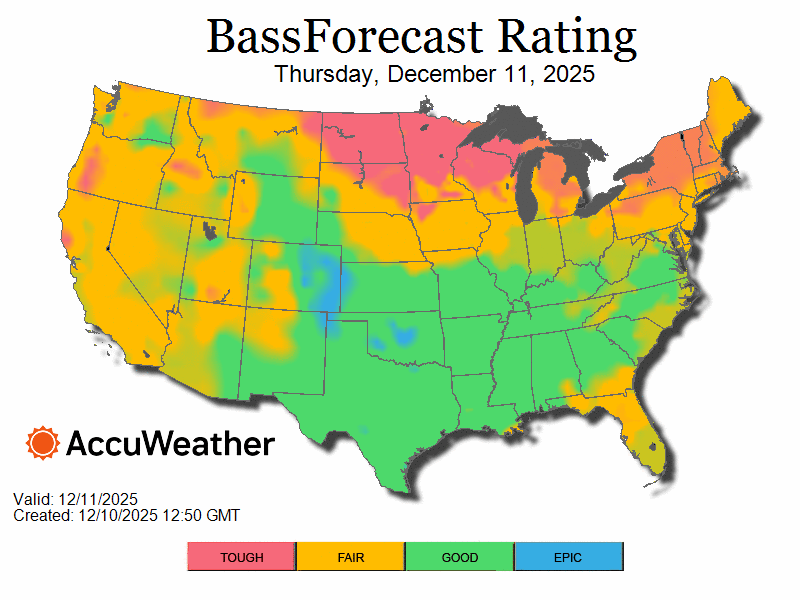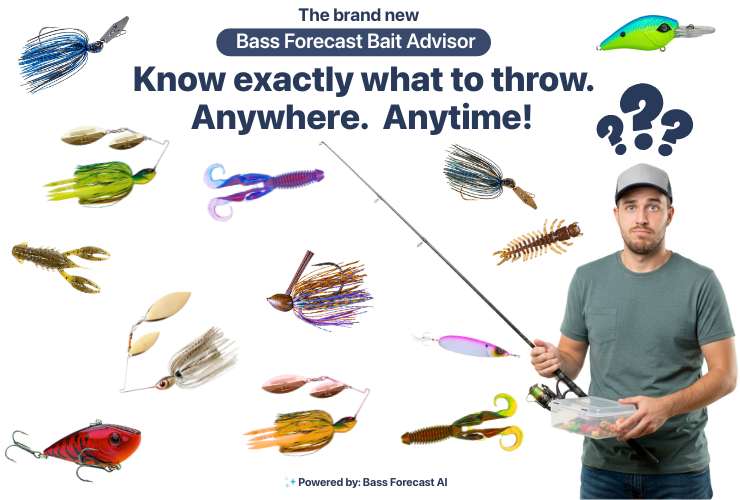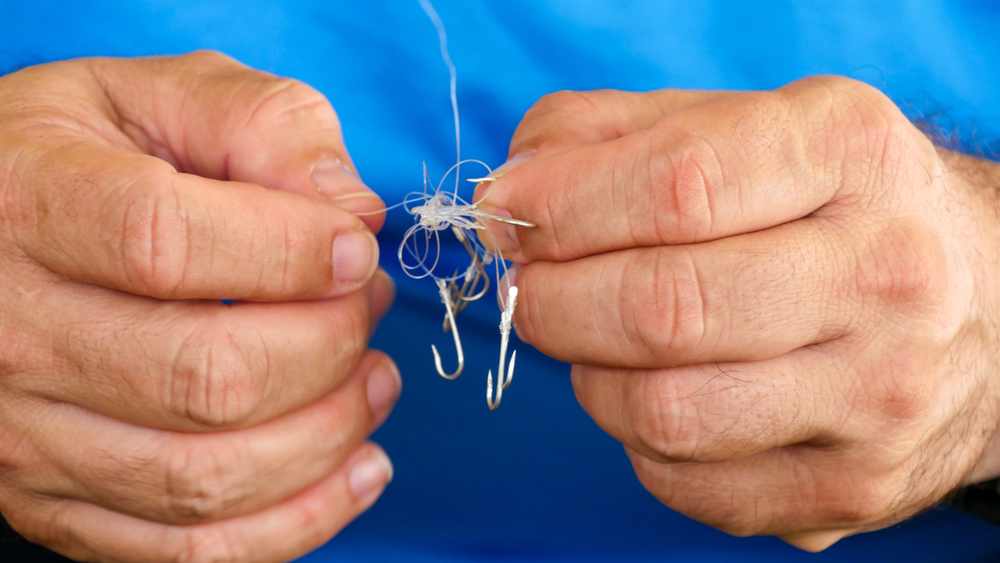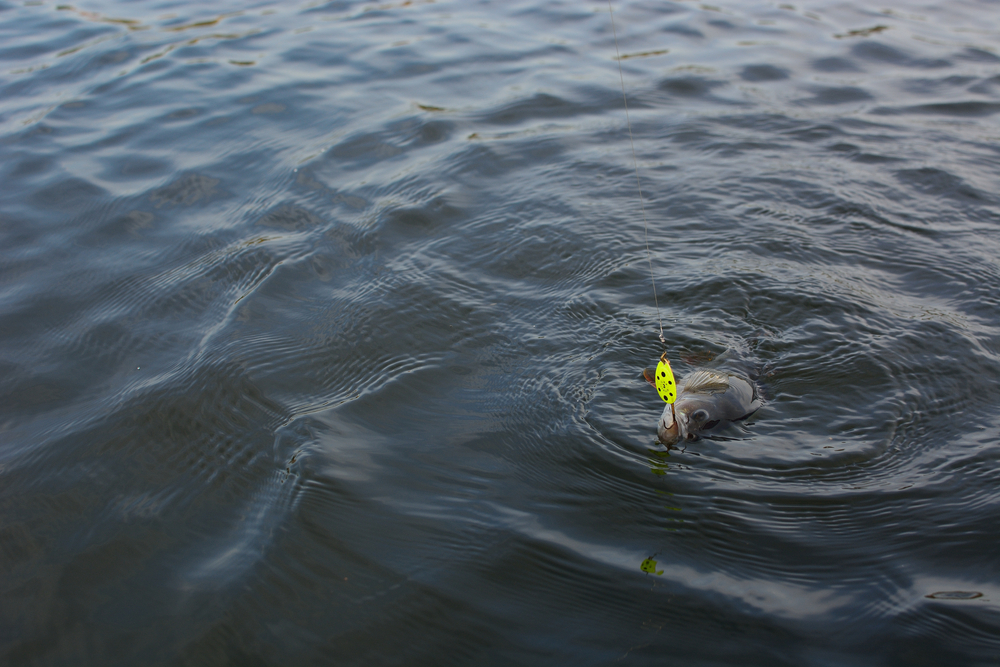Swimbaits for Bass Fishing: Comprehensive Guide
Share this article with every angler you know!
When you look up basic bass fishing lures, you usually hear about jigs, spinnerbaits, and soft plastics, along with all the little variations each of those have. However, there are tons of baits with more advanced designs that can perform just as well, and often better, than those common staples of the sport.
One of those is the swimbait.
If you’re not familiar with them, or you just don’t know how to leverage them effectively, here’s a comprehensive guide to using swimbaits for bass fishing, along with some of our favorite lures to try.
Newsletter Signup
What is a Swimbait?
Like most fishing lures, the name of a swimbait explains it pretty well. It’s a lure that can imitate the general movement of a swimming fish. It “swims” as you reel it in and bounce it around.
In general, you can get two types of swimbaits.
The first is a soft plastic swimbait. These are made of a soft plastic material, just like trick worms and other soft plastics you’re used to, but more detail goes into imitating the form of a fish. Some are extremely life-like and almost perfectly resemble a real fish species, and some are the general profile and focus on generating a lot of action to attract bites.
Then, you have hard-body swimbaits. These are typically little "fish" formed with hard plastic segments. Each segment is on a loose joint, and as you pull it through the water, it makes a swimming motion.
Swimbaits are a versatile and highly effective category of fishing lures designed to mimic the natural swimming motion of baitfish, making them a favorite among anglers targeting predatory species such as bass, pike, muskie, and even saltwater species like striped bass or redfish. Their realistic appearance and lifelike action set them apart from other lures, as they are engineered to deceive even the wariest fish into striking. Below, we’ll dive deeper into the two main types of swimbaits, their uses, and additional details to help anglers understand their applications and advantages.
Soft Plastic Swimbaits
Soft plastic swimbaits are crafted from pliable, durable materials similar to those used in soft plastic worms, creature baits, or crawfish imitations. However, swimbaits are distinct in their fish-like shape and tailored design to replicate the movement and appearance of prey species. These lures come in a wide range of sizes, from small 2-inch models for finesse fishing to large 8-inch or longer versions for targeting trophy-sized fish.
Design and Realism: Some soft plastic swimbaits are hyper-realistic, featuring intricate details like molded scales, 3D eyes, and accurate color patterns that mimic specific baitfish such as shad, bluegill, or trout. Others are more generic, prioritizing exaggerated tail action or vibration to trigger reaction strikes from aggressive fish.
Rigging Options: Soft plastic swimbaits are highly versatile and can be rigged in multiple ways, including:
Weighted Swimbait Hooks: These hooks add weight to the lure, allowing it to sink to desired depths while maintaining a natural swimming action.
Jig Heads: Pairing a swimbait with a jig head provides a streamlined presentation, ideal for fishing in deeper water or around structures.
Texas or Carolina Rigs: These setups allow anglers to fish swimbaits weedless, making them effective in heavy cover like grass or lily pads.
Unweighted: For surface or shallow water fishing, unweighted soft swimbaits can be retrieved to create a subtle, lifelike action.
Applications: Soft swimbaits are particularly effective for finesse fishing or when targeting fish in clear water, where a realistic presentation is critical. Their flexibility allows for a wide range of retrieve speeds, from slow and steady to fast and erratic, depending on the target species and conditions.
Hard-Body Swimbaits
Hard-body swimbaits, often referred to as jointed swimbaits or glide baits, are constructed from rigid materials like hard plastic or wood and are designed with multiple segments connected by hinges or joints. These joints allow the lure to articulate, creating a side-to-side swimming motion that closely resembles a live fish moving through the water.
Construction and Action: The segmented design of hard-body swimbaits is key to their lifelike action. As the angler retrieves the lure, the segments move independently, producing a sinuous, S-shaped motion that can trigger strikes from predatory fish. Some models feature a single joint for a tighter swimming action, while others have multiple joints for a more pronounced, flowing motion.
Types of Hard-Body Swimbaits:
Glide Baits: These swimbaits move in a wide, gliding pattern when twitched or jerked, mimicking an injured or fleeing baitfish. They are particularly effective for targeting large, cautious fish.
Wake Baits: Designed to swim on or just below the surface, wake baits create a visible wake that attracts fish from a distance.
Sinking or Suspending Models: These are used for fishing at specific depths, with some models sinking slowly to mimic a dying fish or suspending in the water column for a pause-and-go retrieve.
Applications: Hard-body swimbaits are often used when targeting larger predatory fish or in situations where a more pronounced action is needed to draw attention. They excel in open water, around structure, or in murky conditions where their vibrations and flash can attract fish from afar.
Choosing the Right Swimbait
Selecting between a soft plastic or hard-body swimbait depends on several factors, including the target species, water conditions, and fishing environment:
Target Species: Soft plastic swimbaits are ideal for bass, walleye, and panfish, while hard-body swimbaits are often preferred for larger predators like muskie, pike, or trophy largemouth bass.
Water Clarity: In clear water, realistic soft swimbaits with natural colors often outperform flashier lures. In stained or murky water, hard-body swimbaits with bold colors and strong vibrations can be more effective.
Season and Conditions: During spawning seasons, smaller swimbaits that mimic juvenile baitfish may be more effective. In colder water, slower retrieves with suspending hard-body swimbaits can entice sluggish fish.
Tackle Considerations: Soft swimbaits can be fished on lighter tackle, while larger hard-body swimbaits often require heavy-duty rods, reels, and line to handle their weight and the aggressive strikes they provoke.
Tips for Fishing with Swimbaits
Vary Your Retrieve: Experiment with steady retrieves, stop-and-go actions, or sharp twitches to find what triggers bites in different conditions.
Match the Hatch: Choose a swimbait that closely resembles the local forage, such as shad, perch, or bluegill, to increase your chances of success.
Use Quality Gear: Swimbaits, especially larger hard-body models, can be heavy and put significant strain on your tackle. Use a rod with enough backbone and a reel with a smooth drag system.
Pay Attention to Depth: Adjust your rigging or retrieve speed to target fish at the appropriate depth, whether near the surface, mid-water column, or along the bottom.
Why Swimbaits Are Popular
Swimbaits have gained immense popularity among anglers due to their ability to produce quality over quantity. While they may not always result in high numbers of fish, they are known for attracting larger, trophy-class fish. Their realistic design and versatile applications make them a go-to choice for both freshwater and saltwater anglers looking to land a personal best.
By understanding the differences between soft plastic and hard-body swimbaits and how to use them effectively, anglers can unlock the full potential of these lures in a variety of fishing scenarios.
Soft Body VS Hard Body Swimbaits for Bass Fishing
Since there are two main types of swimbaits, you’re probably wondering which one you should try.
Well, there’s no real way to definitively answer that. Both of them are proven to work well, and each one has its pros and cons.
We’ll break down the pros and cons of each one so you can make an informed decision.
Pros of Soft Body Swimbaits:
Soft body swimbaits are the ones you’ll usually see other anglers using. This isn’t because they’re better or anything. There are just multiple factors that make them more popular with the common man.
First, they’re far cheaper. Sure, you can find inexpensive hard bodies on weird sites that are too good to be true, but they’re typically not very good. If you take a soft body swimbait and a hard body swimbait of comparable quality levels, the hard body will almost certainly be several times the price of the soft body swimbait. This makes soft-body swimbaits a lot more accessible to the average angler, and it’s a big reason they’re more common.
Then, there’s more fluid motion. Unless you get a very high-quality hard body swimbait, the segments are going to clack or freeze up occasionally, and the overall movement can look odd. A soft body is just a molded piece of silicone. So, it can move a lot more fluidly.
Soft swimbaits can also be made with a variety of tail types. The most common type is the “paddle tail”. A paddle tail shakes violently as the swimbait moves, and this creates more action than a hard swimbait ever will.
Cons of Soft Body Swimbaits:
Soft swimbaits sound great when you look at the benefits, but they’re not perfect.
The most notable drawback is that they don’t swim naturally. Most of them have paddle tails, which are very erratic, but they don’t look like actual fish swimming. They have the profile of a fish flapping its tail like a hummingbird when you real them in. In comparison, a hard-body swimbait tends to flow through the water almost exactly like a fish does as long as its joints are working as intended.
The other main drawback is that they get torn up easily. Bass aren’t gentle when they bite, and they don’t care that you have a premium bait you spent a lot of money on. They’re trying to eat, and they will tear a soft plastic lure up. You can usually get a few good bass on one, but eventually, the tail is coming off, or it’s getting ripped off the hook entirely.
Pros of Hard Body Swimbaits:
Hard-body swimbaits have a lot of pros, as well.
First, they’re pretty durable. Bass won’t tear them up nearly as quickly, and you can usually use the same one for years. So, while they cost more, you get more out of each one.
Secondly, they move in a very life-like fashion. Cheaper ones can lock up and slide through the water very awkwardly, but if you get a good one and maintain it, you’ll get an extremely realistic-looking swimbait that isn’t hard to present well.
Finally, they tend to be a lot bigger. So, they’re typically best for larger bass. If you’re targeting a big bass or musky, these can be your ticket to success.
Cons of Hard Body Swimbaits:
Hard-body swimbaits have some fairly serious flaws.
There’s the price that we talked about already, but it goes beyond that.
First, while they’re technically a lot more durable, they tend to break extremely easily when you make mistakes with them. A bass might not tear one up, but if you cast it into some rocks on the bank, you can bet that the body will crack, and it will stop working properly.
Then, there’s the issue with the action. While hard body baits are more realistic with their movements, most of them don’t slap around and cause a big commotion. They glide through the water, and that motion just speeds up a bit if you retrieve your lure faster.
Finally, when you do lose a hard body bait, it’s a lot more impactful. If you’re relying on one life-like bluegill that costs $40, it throws a wrench in your plans if you crack it against the rocks at the beginning of your trip.
In comparison, if you lose half a soft swimbait from a $10 pack of 6, you just tie a new one on and go about your day. It can throw you off to lose a nice hard-body swimbait. Especially since most anglers don't have several duplicates in their tackle boxes.
Which is Better?
Neither of these options is better than the other. The way you use each one is what matters the most.
We prefer to use larger hard bodies when the bass are moving a bit more slowly and being pickier, but soft swimbaits are our usual go-to for their cost effectiveness, variety, and easiness of replacement.
During the average fishing trip, you’ll usually see us tie on soft plastic swimbaits in whichever variety matches the hatch at any given time.
The debate over whether soft plastic or hard-body swimbaits are superior is a common one among anglers, but the truth lies in understanding that each type has its strengths, and the best choice depends on the fishing conditions, target species, and angler preferences. Below, we explore the factors that influence when and why to choose one over the other, along with practical tips to maximize their effectiveness.
Factors Influencing the Choice
The decision to use a soft plastic or hard-body swimbait hinges on several key variables:
Fish Behavior and Activity Levels: As noted, hard-body swimbaits shine when bass or other predatory fish are moving sluggishly or exhibiting selective feeding behavior, often in colder water or during post-spawn periods. The lifelike, articulated motion of a hard-body swimbait can entice wary fish that might ignore faster-moving or less realistic lures. Conversely, soft plastic swimbaits are versatile enough to be effective across a wide range of fish activity levels, making them a reliable choice for most conditions.
Water Conditions: In clear water, the realistic appearance of a hard-body swimbait can be a game-changer, as fish have a better view of the lure’s details. In murky or stained water, the vibration and action of a soft plastic swimbait’s tail often make it more effective, as fish rely more on their lateral line to detect movement.
Forage Matching: Matching the hatch—choosing a lure that mimics the primary prey in the fishery—is critical. Soft plastic swimbaits offer a broader range of sizes, colors, and profiles, making it easier to match local baitfish like shad, minnows, or bluegill. Hard-body swimbaits, while available in various patterns, are often more specialized and may not always perfectly replicate every forage type.
Fishing Environment: Soft plastic swimbaits are ideal for fishing in heavy cover, such as grass beds or timber, because they can be rigged weedless. Hard-body swimbaits, with their exposed hooks, are better suited for open water or areas with minimal structure to avoid snags.
When Should You Use Swimbaits?
Swimbaits are good choices most of the year. The only time you want to stay away from them is during the summer. You need something violent to shake up the bass and make them want to bite when it’s hot enough to drive them deep into the water column.
We like to use them in the winter when we’re targeting big bass searching for a substantial meal.
The Best Swimbaits to Use
Now that we’ve gotten the general information out of the way, here are several of our favorite swimbaits to get you started.
You can find all of these at Tackle Warehouse if you’re interested.
1: Mattlures U2 Bluegill
The Mattlures U2 Bluegill is a life-like soft-body bluegill that comes in a couple of color patterns mimicking common panfish.
You might have seen something like this a few years ago if you watched fishing-related content on the internet. The big version, the Ultimate Bluegill, was a hit when it was first released. However, it was pretty expensive.
This U2 model is $20. That’s a bit expensive for a single soft plastic lure, but you have to consider how lifelike this is.
Of course, it will get ripped up fairly quickly. So, make sure you use it when it counts unless you can afford to replace $20 lures every couple of trips.
2: Z-Man Gobius Swimbait
This 3-inch soft body swimbait comes in a variety of wild colors, and it has a unique body style compared to most common swimbaits. Beyond having silly bulging eyes, it also features a multitude of thin rubber “fins” that create a lot more action as it moves through the water.
At less than $6 a pack, this is a great deal on a unique swimbait that takes a more aggressive approach to attracting bass.
However, there is one major problem we should warn you about. Some users complain about the hooks that come preinstalled. You can’t replace them, and they might bend out on larger bass. This won’t be a problem on the bass most anglers catch daily, but it would be a pretty big disappointment to start hauling in your next personal best just for it to slide right off the hook.
3: Berkley PowerBait Swim Shad
The Berkley PowerBait Swim Shad is, for all intents and purposes, a pretty standard soft plastic paddle tail. It has a built-in weight and hook, its general body shape isn’t anything special, and it kicks water around like crazy.
Two features make it stand out, though.
First, Berkley puts extra effort into making these lures look realistic via their coloring and special 3D eyes that can catch the light and shine just like natural fish eyes.
Secondly, Berkley has infused these with its renowned scent and flavor compounds to give you an extra edge.
Unfortunately, the scent compound does wear off with time. So, if you use these for multiple trips, you can expect them to start smelling just like any other lure. When that happens, they are essentially nice paddle-tail soft bodies. There's nothing wrong with that, but you should know what to expect.
A good way to help with this is to take the packaging with the lures you’re not using still in it, and then toss all that in a freezer bag before pushing the air out. This will keep that liquid scent stuck in the lures until you start using them, and it can refresh the ones you’ve used a bit.
4: Huddleston Deluxe 8-inch Trout
Huddleston Deluxe 8-inch Trout is a soft plastic swimbait that’s high on the cost and quality spectrum. It’s an 8-inch trout lure that looks, and somewhat feels, like the real deal.
This is great for bigger fish, and we’d recommend busting it out in the winter, but it’s not something you’re going to try out every time you go fishing. Also, you’ll want a much heavier rod to use with it. It's a pretty chunky lure.
With that being said, keeping one around is a good idea. However, at $35 per lure, it’s not one we’d recommend using for everything.
5: Mattlures Hard Gill Swimbait
Mattlures Hard Gill Swimbait is the only hard-body swimbait we’ll be talking about, and it’s essentially a larger, hard-body, version of the U2 we mentioned. It features a segmented body and a life-like appearance made of hard plastic.
This highly resilient swimbait is going to be a great choice year-round, and its natural movements mean you don’t have to work too hard to trick a bass with it.
The issue is the price of this one. At $85, it’s hard to recommend this to the average angler.
Especially as something you’d want multiples of. However, if you can save up for a nice lure every once in a while, and you won’t have a meltdown if it gets snapped off your line, it will make a fine addition to your collection. It looks so high-end that you might want to just go ahead and mount it on a wall instead of using it.
Find Places to Use Your New Swimbaits at Bass Forecast
If you’re looking for somewhere to use your new collection of swimbaits for bass fishing, check out the Bass Forecast fishing app.
You’ll find a huge selection of waterway maps, real-time weather information, a spot-on solunar, various other baits, and even more tips and tricks on how to use swimbaits.









.png)
.png)